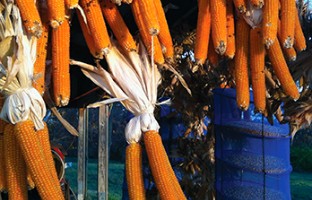Popcorn season: Summers bounty in winter

Before dusk five deer gingerly high-step their way single file uphill through the snowy woods, stopping to browse the few dry leaves still clinging to weeds and multiflora rosebushes. They blend in with the brush and are periodically obscured entirely by the snow that’s whipping in updrafts and downsweeps.
My family and I are browsing too, although in greater variety, quantity, and comfort than the deer. Tonight I enjoyed a hearty dinner of roasted beets, carrots, potatoes, parsley root, turnips, and burdock. Plenty more roots are in the cellar, and my refrigerators and freezers are packed full of the colors and flavors of summer. In the stand-up freezer are jugs of my neighbor’s apple cider and my sister’s apple-pear cider and apple-pear-aronia cider. In the chest freezer are Ziploc bags full of “for-us” seconds from my brother’s vegetable fields, everything from tomatoes to edamame to Anaheim peppers. And in yet another freezer are packages of my sister’s chickens, another sister’s pork, and beef from my dad—all from animals that are fed a varied diet, including lots of flawed but still nutritious produce from the fields. Finally, in the cabinets and on the counters are jars of dried herbs, dry beans, and my favorite winter snack, popcorn.
There’s nothing quite so heartwarming and mouthwatering as the sound and smell of popcorn on the stove on a cold winter’s night. The dads in most of the other families I knew growing up presided over meat on the grill. My dad presided over popcorn on the stove, and I’ve loved and been fascinated by the process of popping popcorn ever since he first let me stand on a chair and watch.





